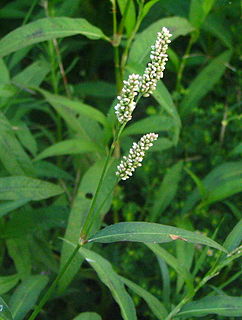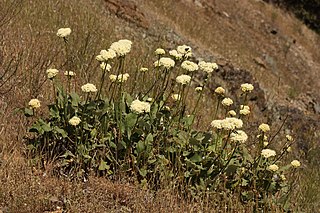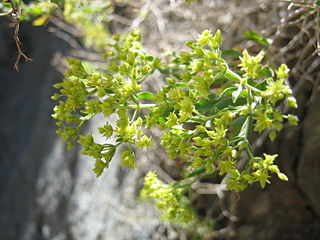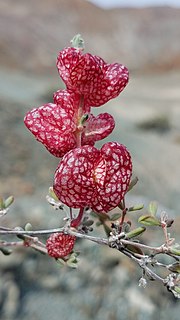
The Polygonaceae are a family of flowering plants known informally as the knotweed family or smartweed—buckwheat family in the United States. The name is based on the genus Polygonum, and was first used by Antoine Laurent de Jussieu in 1789 in his book, Genera Plantarum. The name may refer to the many swollen nodes the stems of some species have, being derived from Greek, poly meaning 'many' and gony meaning 'knee' or 'joint'. Alternatively, it may have a different derivation, meaning 'many seeds'.

Coccoloba is a genus of about 120–150 species of flowering plants in the family Polygonaceae, which is native to the Neotropics. There is no overall English name for the genus, although many of the individual species have widely used common names.

Eriogonum is a genus of flowering plants in the family Polygonaceae. The genus is found in North America and is known as wild buckwheat. This is a highly species-rich genus, and indications are that active speciation is continuing. It includes some common wildflowers such as the California buckwheat.

Eriogonum inflatum, the desert trumpet, is a perennial plant of the family Polygonaceae. The plant possesses very small yellow or pink flowers and an inflated stem just below branching segments. Eriogonum: from the Greek erion, "wool", and gonu, "joint or knee", in reference to the hairy or woolly joints of some of the species of the genus, but not particularly inflatum. It is found in the Mojave Desert and other deserts.

Gilmania luteola is a rare annual plant in the Buckwheat family (Polygonaceae).
Benedictus Hubertus Danser, often abbreviated B. H. Danser, was a Dutch taxonomist and botanist. Danser specialised in the plant families Loranthaceae, Nepenthaceae, and Polygonaceae.

Rumex maritimus, commonly called golden dock, bristle dock, or seashore dock, is an annual plant species of the genus Rumex. Rumex maritimus grows in Argentina, Burma, Canada, China, and the United States. It is native to Canada and most of the 48 states. The life span of Rumex maritimus is rarely biennial in moist environments. This herb belongs to the family Polygonaceae.

The monotypic genus Dedeckera contains the single species Dedeckera eurekensis, a plant known by the common name July gold which is endemic to California. It is found in the mountains east and south of the Sierra Nevada, especially the Inyo and White Mountains.
Knorringia is a genus of plants in the family Polygonaceae. It is native to Central Asia and Siberia.

Hollisteria is a genus of plants in the family Polygonaceae with a single species, Hollisteria lanata. It is endemic to California. It is known by the common name false spikeflower.

Harfordia macroptera is a woody perennial in the family Polygonaceae commonly known as rabbit's purse. It is the sole species in the genus Harfordia, which is endemic to the Baja California Peninsula. This plant is characterized by a unique, conspicuous bladder embellished with red to purple veins that surround the fruit. The sac-like structure is actually a dramatically modified bract, and assists in dispersal of the seeds through the wind.
Aristocapsa is a genus of plants in the family Polygonaceae with a single species, Aristocapsa insignis, restricted to California. It is known by the common names Indian Valley spineflower or Indian Valley spinecape, and it is endemic to the inland southern Coast Ranges of Monterey and San Luis Obispo Counties.

Chorizanthe fimbriata, the fringed spineflower, is an annual plant in the family Polygonaceae, the buckwheats. It is a member of the genus Chorizanthe, the spineflowers, and is native to southern California and northern Baja California.

John Thomas Howell was an American botanist and taxonomist. He became an expert of Eriogonum (buckwheat) species, which are widely represented in the native California flora.

Eriogonum callistum is a rare species of wild buckwheat, known by the common name Tehachapi buckwheat.

Polygonum dentoceras is a rare species of flowering plant in the knotweed family known by the common names sandlace, woody wireweed, and Small's jointweed. It is endemic to Florida in the United States, where it is limited to the central ridges of the peninsula, including the Lake Wales Ridge. It is threatened by the loss and degradation of its habitat. It is a federally listed endangered species of the United States.

Reynoutria is a genus of flowering plants in the family Polygonaceae. The genus is native to eastern China, Eastern Asia and the Russian Far East, although species have been introduced to Europe and North America. Members of the genus, including R. japonica and its hybrid with R. sachalinensis, are highly invasive plants.

Polygonoideae is a subfamily of plants in the family Polygonaceae. It includes a number of plants that can be highly invasive, such as Japanese knotweed, Reynoutria japonica, and its hybrid with R. sachalinensis, R. × bohemica. Boundaries between the genera placed in the subfamily and their relationships have long been problematic, but a series of molecular phylogenetic studies have clarified some of them, resulting in the division of the subfamily into seven tribes.

Duma is a genus of shrubby flowering plants in the family Polygonaceae, subfamily Polygonoideae. The genus was separated from Muehlenbeckia in 2011. The native range of the genus is Australia.
Johanneshowellia is a genus of flowering plants belonging to the family Polygonaceae.
















